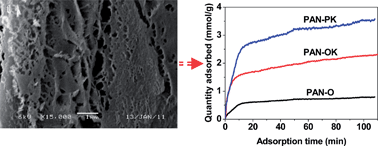Hierarchical porous polyacrylonitrile-based activated carbon fibers for CO2 capture†
Abstract
Hierarchical porous activated carbon fibers with a BET surface area of 2231 m2 g−1 and a pore volume of 1.16 cm3 g−1 were made from

* Corresponding authors
a
Key Laboratory of Carbon materials, Institute of Coal Chemistry, Chinese Academy of Sciences, Taiyuan, Shanxi, P. R. China
E-mail:
shenwzh2000@yahoo.com
Tel: +86 351-4199009
b
State Key Laboratory of Coal Conversion, Institute of Coal Chemistry, Chinese Academy of Sciences, Taiyuan, Shanxi, P. R. China
E-mail:
fanwb@sxicc.ac.cn
Tel: +86 351-4199009
Hierarchical porous activated carbon fibers with a BET surface area of 2231 m2 g−1 and a pore volume of 1.16 cm3 g−1 were made from

 Please wait while we load your content...
Something went wrong. Try again?
Please wait while we load your content...
Something went wrong. Try again?
W. Shen, S. Zhang, Y. He, J. Li and W. Fan, J. Mater. Chem., 2011, 21, 14036 DOI: 10.1039/C1JM12585K
To request permission to reproduce material from this article, please go to the Copyright Clearance Center request page.
If you are an author contributing to an RSC publication, you do not need to request permission provided correct acknowledgement is given.
If you are the author of this article, you do not need to request permission to reproduce figures and diagrams provided correct acknowledgement is given. If you want to reproduce the whole article in a third-party publication (excluding your thesis/dissertation for which permission is not required) please go to the Copyright Clearance Center request page.
Read more about how to correctly acknowledge RSC content.
 Fetching data from CrossRef.
Fetching data from CrossRef.
This may take some time to load.
Loading related content
